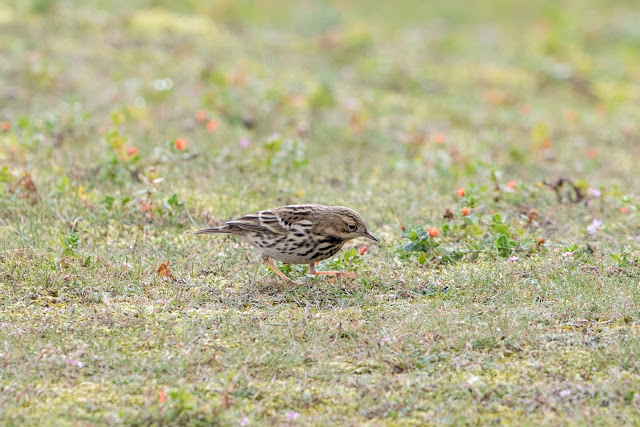The night had been pretty wet so I was hopeful it hadn't flown off overnight but you never know. There were 5 other birders on site when I arrived at the southern end of the point and we started to scan the assembled pipits for our rarer target.
The site is long and narrow, a strip of grass bounding the beach, with a strip of rough ground separating the two. There were good numbers of birds, mainly meadow pipits and goldfinches but also a few wheatears hanging around. There were still swallows moving through almost constantly and we even picked up a very late sand martin.
What we were really looking for though was a pipit with a red-throat, albeit a very dull one as it wasn't in full breeding finery, but one also with a paler belly, clearer contrasting black marks on the flanks and what are described as "tramlines" on its back. After about 30 minutes we were spreading out as there was no sign, when I picked up a possible bird on the deck. It was only a brief glimpse though as annoyingly a hobby came over and moved the whole flock on. Simultaneously though another birder came jogging up saying he had seen and heard the red-throated pipit fly over towards us. Good that it was definitely still here, but the view I had was nowhere near good enough to claim a tick. For another 30 minutes, as the crowd swelled to I suppose 20, we tried to cover the flat grassy area looking for the meadow pipit flock, which were eventually tracked down to an area 200 yards back towards the observatory.
We had lots of "fun" grilling the assorted pipits and had a few excitements with birds which initially looked good but failed the test, as the one above. Finally though, we did have a good candidate and I got onto it well enough to clinch the main points. A distant view but easily enough to claim the tick. It was always mobile though and we quickly lost it and despite searching we couldn't track it down again. As time was getting on now, I decided to give it up and walked off to the car park. I had just stopped to have a last scan of the grass when one of the birders I had been talking to came past. "Not got it have you?'' he joked just as I spotted a really light coloured pipit no more than 20 yards away!! "Yes, I think I have!!!"
So, why a red-throat? It was really light coloured compared to her more buffy mipits, with the clean flanks and the very contrasting black ticks on its side and chest. On the lower photo you can also see the "tram lines", the white parallel stripes going down its back.
On this one, you can also see the starting of its red-throat. In full breeding finery this is much more defined, but here it is more peachy in colour.
We just started to creep a bit closer to it when, very annoyingly, a couple walked straight down in front of us and flushed the bird. Did they not see us with are 'scopes and a bloody great camera pointing across where they were walking!!!!
That was my cue to leave though, very happy with a lifer in the bag. I had one more stop on the way home, at Little Marlow near Beaconsfield for a yellow-browed warbler. This was really tricky. It was calling reasonably often but was horrendously elusive in thick cover. After an hour I had one or two poor views and managed to take this amazing photo of it! Enough to see the wing-bars but not a lot else!
Home was calling though with a lifer and another good year-tick in the bag. Weymouth this weekend but weather on Sunday looks awful. Still, might drop some goodies for Monday!!


























































